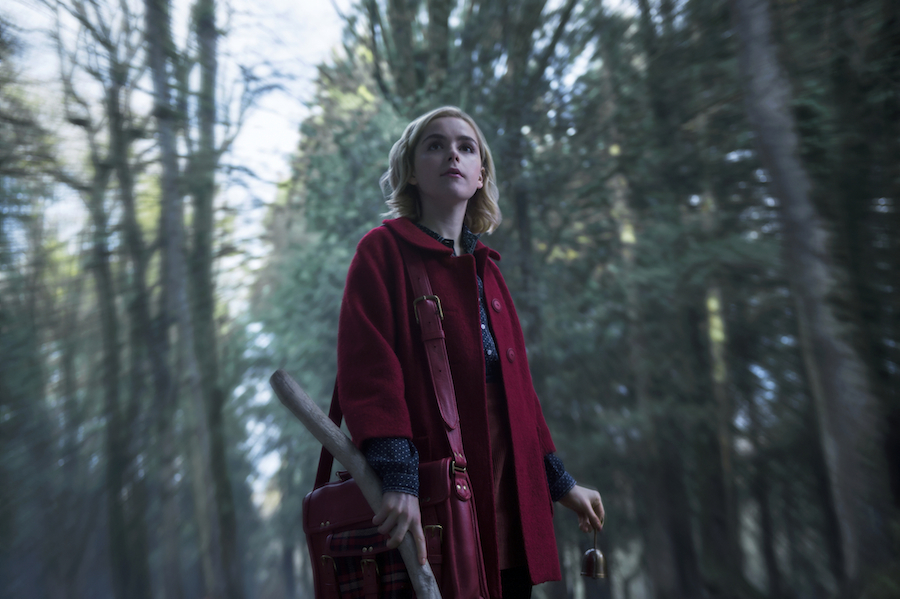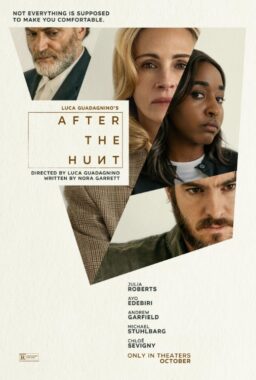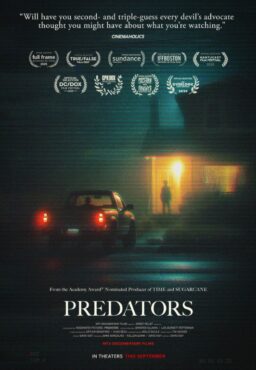All it takes is one great role for an actor to be rediscovered. Kiernan Shipka had already proven herself to be a formidable talent, growing up before our eyes on AMC’s “Mad Men” while displaying impressive range in a diverse array of genres—from the moody supernatural drama of Andrew Proz Palermo’s “One and Two” and the rousing adventure of Nickelodeon’s “The Legend of Korra” to the uproarious satire of her Funny or Die web series, “Child Star Psychologist.”
Yet it was her startling dive into horror, courtesy of Osgood Perkins’ masterful 2015 debut feature, “The Blackcoat’s Daughter,” that revealed the astonishing breadth of her potential. Shipka played Kat, an alienated girl yearning to fill the void left by her absent parents. After answering the call of a horned demon that may or may not exist solely in her head, Kat undergoes a malevolent transformation that brings her a strange sense of empowerment, especially when it terrifies her peers. Aside from one climactic howl, she never raises her voice, even when hurling an expletive at a pair of bewildered caregivers. Overcome by the sudden power that has taken hold of her speech, Kat stares at her prey with fierce eyes as a tear rolls down her cheek. Later on, when she calmly raises her arms and replies, “Hail, Satan,” she appears fearsomely in control rather than out of her mind. Like Norman Bates, she’s simply focused on getting her job done, no matter how gory it may be.
As confirmed by Shipka in a recent BUILD interview, “The Blackcoat’s Daughter” turned out to be a crucial inspiration for Archie Comics CCO Roberto Aguirre-Sacasa when developing the small screen adaptation of his own recent comic book series, Chilling Adventures of Sabrina. Whereas “Riverdale,” Aguirre-Sacasa’s hit show on The CW Network, echoes “Twin Peaks” in its self-aware subversion of the squeaky clean adolescent archetypes once modeled after Andy Hardy, his reimagining of Sabrina’s teenage witchery pays homage to numerous genre-defining classics, lending a cinematic aura to its metaphysical mischief. Though Sabrina couldn’t be further removed from Kat in terms of her thriving social life and sunny disposition, she also lost her mother and father at a young age, and is on a journey toward finding her place in the world. Melissa Joan Hart’s sitcom incarnation of the character had no knowledge of her own capacity for witchcraft until she turned 16. The first season of Aguirre-Sacasa’s “Sabrina” series, debuting on Netflix this Friday, October 26th, opens with its titular heroine counting down the days on her calendar—in one of many shots evocative of “Blackcoat”—toward the same pivotal birthday. What makes Shipka’s Sabrina more in step with the original comic book character dating back to 1962 is the fact that she is well-aware of her magic from the get-go. This is an origin story not about discovering one’s powers but learning to own them.

Sabrina appears to have been a role tailor-made for Shipka, and every one of the first season’s ten episodes is anchored by her captivating performance. Aguirre-Sacasa provides a stellar showcase for many of the abilities she utilized in Perkins’ film, from her lovely singing voice to the arresting strength she derives from her vulnerability. No special effects or badass one-liners are needed for Shipka to register as a towering force onscreen. She traumatized me in “The Blackcoat’s Daughter” without the use of demonic prosthetics (quickly scrapped by the director), and on “Chilling Adventures of Sabrina,” she casts her indelible spell with the layers of emotional nuance rippling across her face. Just as Kat’s world was shrouded in brown colors intended to signify the snugness of her newfound identity, the red glow of Sabrina’s wardrobe conveys a very different type of warmth. How refreshing it is to see a modern series built around a teenager whose most defining feature is an innate goodness.
Though each hour-long chapter of the show is linked by a continuous narrative, the “Adventures” in the title correctly suggests an episodic use of secondary conflicts that Sabrina must face in her everyday life. The child of a male witch and female mortal, she is dubbed a “half-breed” (or “mudblood,” as termed by J.K. Rowling), requiring her to straddle the line between the magical realm and the human one occupied by friends oblivious to her bloodline. The observation made by Aunt Hilda (a delightful Lucy Davis) that Sabrina’s father could’ve been a movie star “like Cousin Montgomery” is a sly nod to the star of Sol Saks’ beloved sitcom, “Bewitched,” about a witch-turned-housewife who refuses to suppress her otherworldly skills, much to the dismay of her mortal husband. In her stubborn battle against various forms of oppression at school, such as library censorship and hazing rituals, Shipka’s Sabrina is a kindred spirit of Elizabeth Montgomery’s Samantha. She is a terrible liar precisely because she is so sincere, yet with the aid of her witchcraft, Sabrina pulls off some satisfying pranks that earn many of the show’s biggest laughs. A priceless bit involving truth extraction reminded me of the “Bewitched” episode where Samantha’s husband, Darrin, is hexed by his mother-in-law, causing him to speak only in toddler-appropriate language at a business meeting (“I made a boo-boo,” he explains).

Never verging into the family-friendly silliness of Hart’s “Sabrina, the Teenage Witch,” where the protagonist had a penchant for inadvertently turning mean girls into pineapples, “Chilling Adventures of Sabrina” still peppers its increasingly grim subject matter with richly earned bursts of euphoria, starting with Sabrina’s dance to “Be My Baby” after professing her love for mortal boyfriend Harvey Kinkle (Ross Lynch). Like Shipka, Lynch is remarkably gifted at portraying shunned youth on the cusp of destruction, as seen in Marc Meyers’ “My Friend Dahmer,” and it’s a joy to watch them both liberated by the inherent sweetness of their characters, not to mention the palpable chemistry that they share. Episode three contains a beautiful sequence of consensual intimacy triggered by Sabrina’s urgent request that Harvey check her body for a birthmark. What could’ve devolved into a squirm-inducing leering session instead becomes a touching portrait of Harvey’s sensitivity. He handles her body with the utmost respect, while insisting that he strip down as well because “fair is fair.”
Apart from its nostalgic trappings, the appeal of “Stranger Things” lies in its endearing band of misfits that drive the story, and there’s no question they’d get along splendidly with Sabrina’s cherished companions. Instead of exchanging witty banter with her cat, Salem (whose dialogue is limited to expressive meows), she finds an even better scene partner in Ambrose (Chance Perdomo), her pansexual cousin whose exuberance masks an underlying bitterness at the curse keeping him housebound. Sabrina’s school chums, Rosalind (Jaz Sinclair) and Susie (non-binary actor Lachlan Watson), further expand the show’s fully dimensional inclusivity, while the aunts that raised her—the irreverent Hilda and uptight Zelda (Miranda Otto)—form a most amusing comic duo.
To say there are multiple parallels that could be made between this “Sabrina” series and “Harry Potter” would be an understatement, a fact certainly not lost on Aguirre-Sacasa and his team of writers—after all, one of the bullies’ last names is Dursley. Yet rather than settle on derivative formulas, the show often soars to the provocative heights of Broadway’s “Wicked” and Robert Eggers’ “The Witch,” which both illuminated the exhilarating aspects of defying gravity, breaking free of societal strictures by “living deliciously” (Sabrina notes that there are many “delicious” reasons to be a witch). Of course, devoting one’s life to the Dark Lord comes with a price, and when Sabrina questions why their unholy leader is terrified of granting women freedom and power, the response she receives is unfiltered perfection: “He’s a man, isn’t he?”
The show is at its best when skewering the patriarchal oppression of organized religion, an ancient scourge no less prevalent in the witch’s own belief system that hypocritically derides the “false god” of Christianity. “Why must I save myself for the Dark Lord?” Sabrina demands, “Why does he decide what I do with my body?”, to which Zelda sighs, “Should’ve been homeschooled.” The crimson hue of Sabrina’s attire is mirrored by the apple she plucks off a tree, a biblical symbol of the knowledge God had intended on keeping from Eve. Her refusal to blindly obey orders breeds a healthy level of skepticism, especially when confronted by the sort of frightening fanaticism memorably explored in the original “Carrie” and “The Blackcoat’s Daughter” (for more context, read my in-depth appreciation of Perkins’ film here—after seeing the film, of course).

The coven’s High Priest, Father Blackwood (Richard Coyle), and Sabrina’s principal, Mr. Hawthorne (Bronson Pinchot), are equally loathsome examples of puritanical masculinity, yet neither are a match for the manipulative games of Mary Wardell (Michelle Gomez), a mysterious, ever-watchful teacher on par with Severus Snape. Just as Sabrina’s pals debate the symbolism in their favorite movies, particularly “Night of the Living Dead”—which is referenced at the beginning only to later become unearthed, so to speak, toward the end—the show’s thinly cloaked commentary provides viewers with plenty to chew on. An episode deftly timed for Thanksgiving is chock-full of metaphorical subtext regarding the Native American genocide, while Principal Hawthorne voices the misogyny of men complicit in sexual abuse who label the #MeToo movement a “witch hunt.” Among the many shared understandings that exist between Sabrina and Harvey, one is the plight of being torn between two worlds. In Harvey’s case, it’s the world existing inside the local mine overseen by his father (Christopher Rosamond), and the one existing outside of it, above ground. Harvey’s dad may be the show’s most monstrous character of all, embracing a tragic occurrence as an opportunity to publicly shame his son while spewing propaganda about his chosen way of life, which is as destructive to the environment as the man’s words are to his family’s mental health. As a rebuke against the tribalism keeping witches and mortals apart, the program illustrates how their worlds really aren’t all that different from one another, and how Sabrina’s unwillingness to conform flies in the face of them both.
With season two currently in production and slated for release next year, “Chilling Adventures of Sabrina” could theoretically join with “Riverdale” in creating its own comic book-based expanded universe. Aguirre-Sacasa already has ideal subject matter for a cross-over in the form of his Afterlife with Archie series, where the red-headed hero must team up with his buddies to combat a zombie apocalypse when it reaches their hometown. Sabrina’s town of Greendale is right next door to Riverdale, a fact mentioned only once this season, and that’s probably a good thing. Having the show debut on a network separate from the one airing “Riverdale” provided enough distance for it to have a tone and charm all its own, avoiding the pitfalls of interconnected exposition that mars many a Marvel vehicle.
If anything, “Sabrina” has more in common with the other seasonal 10-hour epic released on Netflix this month—Mike Flanagan’s riveting limited series, “The Haunting of Hill House”—yet their most glaring similarities aren’t worth replicating. Both shows incorporate cartoonish CGI (though “Sabrina” thankfully has far more practical effects) as well as use the repetitive refrain of “I have to fix this” so often in later episodes, it seems designed for a future Netflix drinking game. Weirdly enough, the best episode in each of the shows is the fifth one—both benefit from an ingenious structure that probes deeper into the minds of its characters. The longevity of Sabrina’s adventures has yet to be determined, but with Shipka and the gang signed on for the full ride, I’d gladly follow this witch to the moon and back.












